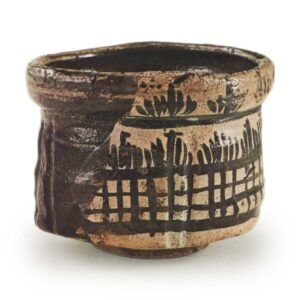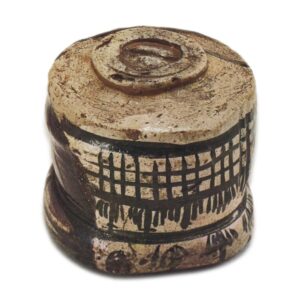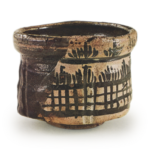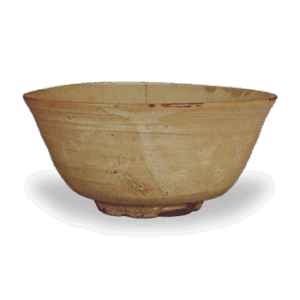

Height: 9.2cm
Diameter: 10.6-11.0cm
Foot diameter: 5.6-5.8cm
Height: 0.5cm
The clay is a soft grayish clay, and the shape is unusual, being a cylindrical shape on all four sides. It is painted with irises and plaid patterns in an innocent style on the white background, and the name “Masagaki” is based on the plaid pattern. Although this is a relatively gentle piece for an Oribe tea bowl, the design is still characteristic of Oribe ware, with its unconventional and witty contrast between the black and white. For example, the bold thick rim around the rim of the bowl strengthens the tone, but the overall shape is well-balanced and solid, which is truly the design power of Oribe.
The effect of the pattern is well calculated, with vertical lines arranged appropriately against the coarse lathe marks, and black plaid patterns layered on top of the white background, or white lines drawn horizontally in the black background of the thick rim, and the white rim of the white background tightened with black lines in response. At first glance, they may seem to be rough and careless, but in fact they are very carefully thought out, and you may be surprised to find that they are even deeply intellectual.
In addition to the improvised designs that are meaningless, there are also many designs that are taken from dyeing and weaving designs and arranged skillfully. In fact, there may be more designs that are related to dyeing and weaving designs. Whether it’s the irises or the plaid, they are actually materials from classical dyeing and weaving designs, and here they have been well digested in the potter’s mind, and are beautifully transformed with the unique sensibility of Oribe designs.
The interior is a deep, beautiful jet black. However, there are three triangular fire holes of various sizes near the rim, which are arranged in a pattern, creating a single scene.
Next, the foot ring is a wide, low, carved-out design, and there is a large single character carved into the center of the ring. This is commonly known as the signature of Seto Jussaku I, Genzo. In addition to the Jussaku, there is a tradition of six Rokusaku, and it is said that the six Rokusaku were chosen by Nobunaga, and the ten Jussaku were chosen by Oribe Furuta, and the carving marks of the kiln marks are handed down, but the degree of truth of this popular tradition is very doubtful.
However, it is worth noting that in the case of Shino and Oribe-type wares, we often see single-character marks carved into the foot ring, or T-shaped, cross-shaped, pine needle-shaped, etc. marks carved inside and outside the foot ring, and in many cases, these wares are quite excellent. For example, we also see single-character marks carved into the foot ring of Kuro-Oribe wares. However, it is difficult to accept that the style of the two is the same. In other words, today, it is thought that these carved inscriptions are not the signatures of the artists, but rather a way of distinguishing between the different orders, and this seems to be a reasonable idea.
The history of this tea bowl is unknown, other than that it was originally owned by the Fujita family.
There are no accessories of particular note.








